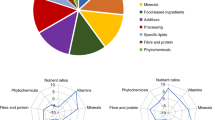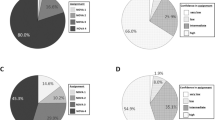Abstract
Background/Objectives:
Nutrient profiling models classify the healthiness of foods based on their nutritional composition and provide the science that underlies nutrition signposting schemes. The two objectives were to examine the construct validity of the Health Star Rating (HSR) system by determining its diagnostic accuracy and to detect the optimal HSR cutoff points to define healthiness in packaged dairy foods. We hypothesised that ultra-processed dairy, defined by NOVA, would have less stars (less healthy) and non-ultra-processed dairy would have more stars (more healthy).
Subjects/Methods:
The diagnostic accuracy of the HSR system used for 621 dairy foods for sale in an Australian regional supermarket was investigated. The healthiness of packaged dairy was measured using the NOVA food classification system.
Results:
The dairy beverages model was found to discriminate between healthy and less healthy dairy beverages as classified by NOVA (AUC: 0.653; 95% CI: 0.556–0.750; P=0.005). A receiver operating characteristic curve analysis for dairy beverages demonstrated that the optimal cutoff point corresponded to a rating of four stars. There was no discrimination power when using the HSR for predicting the health value of yoghurt and other dairy, or cheeses.
Conclusions:
At the optimal cutoff point of four stars the HSR has a high sensitivity but a low specificity to correctly classify healthy packaged dairy beverages, as defined by NOVA. We provide evidence to support the construct validity of the HSR model for dairy beverages, but not for the models used for yoghurts and other dairy products, or cheeses.
This is a preview of subscription content, access via your institution
Access options
Subscribe to this journal
Receive 12 print issues and online access
$259.00 per year
only $21.58 per issue
Buy this article
- Purchase on SpringerLink
- Instant access to full article PDF
Prices may be subject to local taxes which are calculated during checkout

Similar content being viewed by others
References
Roberto CA, Bragg MA, Schwartz MB, Seamans MJ, Musicus A, Novak N et al. Facts up front versus traffic light food labels: a randomized controlled trial. Am J Prev Med 2012; 43: 134–141.
Commonwealth of Australia Health Star Rating System 2015. [cited 2016 Jan] Available from http://healthstarrating.gov.au/internet/healthstarrating/publishing.nsf/Content/Home.
Arambepola C, Scarborough P, Rayner M . Validating a nutrient profile model. Public Health Nutr 2007; 11: 371–378.
Rayner M, Scarborough P, Kaur A . Nutrient profiling and the regulation of marketing to children. Possibilities and pitfalls. Appetite 2013; 62: 232–235.
World Health Organisation/ International Association for the Study of Obesity Nutrient Profiling: Report of a WHO/IASO technical meeting 2010[cited 2012 Oct]. Available from: http://www.who.int/nutrition/publications/profiling/WHO_IASO_report2010/en/index.html.
Townsend MS . Where is the science? What will it take to show that nutrient profiling systems work? Am J Clin Nutr 2010; 91: 1109S–1115S.
Hebden L, King L, Kelly B, Chapman K, Innes-Hughes C, Gunatillaka N . Regulating the types of foods and beverages marketed to Australian children: how useful are food industry commitments? Nutr Diet 2010; 67: 258–266.
Labouze E, Goffi C, Moulay L, Azaïs-Braesco V . A multipurpose tool to evaluate the nutritional quality of individual foods: Nutrimap. Public Health Nutr 2007; 10: 690–700.
Roberto CA, Bragg MA, Livingston KA, Harris JL, Thompson JM, Seamans MJ et al. Choosing front-of-package food labelling nutritional criteria: how smart were 'Smart Choices'? Public Health Nutr 2011; 15: 262–267.
Azais-Braesco V, Goffi C, Labouze E . Nutrient profiling: comparison and critical analysis of existing systems. Public Health Nutr 2006; 9: 613–622.
Gregori D, Foltran F, Verduci E, Ballali S, Franchin L, Ghidina M et al. A genetic perspective on nutritional profiles: do we still need them? J Nutrigenet Nutrigenomics 2011; 4: 25–35.
Katz DL, Njike VY, Rhee LQ, Reingold A, Ayoob KT . Performance characteristics of NuVal and the Overall Nutritional Quality Index (ONQI). Am J Clin Nutr 2010; 91: 1102S–1108S.
Scarborough P, Boxer A, Rayner M, Stockley L . Testing nutrient profile models using data from a survey of nutrition professionals. Public Health Nutr 2007; 10: 337–345.
Fulgoni VL, Keast DR, Drewnowski A . Development and validation of the nutrient-rich foods index: a tool to measure nutritional quality of foods. J Nutr 2009; 139: 1549–1554.
Julia C . Application of the British Food Standards Agency nutrient profiling system in a French food composition database. BJN 2014; 112: 1699–1705.
Monteiro CA, Cannon G, Moubarac JC, Martins AP, Martins CA, Garzillo J et al. Dietary guidelines to nourish humanity and the planet in the twenty-first century. A blueprint from Brazil. Public Health Nutr 2015; 18: 2311–2322.
Louzada ML, Bortoletto Martins AP, Silva Canella D, Galastri Baraldi L, Bertazzi Levy R, Moreira Claro R et al. Ultra-processed foods and the nutritional dietary profile in Brazil. Rev Saude Publica 2015; 49: 38.
Louzada ML, Martins AP, Canella DS, Baraldi LG, Levy RB, Claro RM et al. Impact of ultra-processed foods on micronutrient content in the Brazilian diet. Rev Saude Publica 2015; 49: 45.
Moubarac JC, Parra DC, Cannon G, Monteiro CA . Food classification systems based on food processing: significance and implications for policies and actions: a systematic literature review and assessment. Curr Obes Rep 2014; 3: 256–272.
Moubarac JC, Batal M, Louzada ML, Steele EM, Monteiro CA . Consumption of ultra-processed foods predicts diet quality in Canada. Appetite 2017; 108: 512–520.
Steele EM, Baraldi LG, Louzada ML, Moubarac JC, Mozaffarian D, Monteiro CA . Ultra-proecssed foods and added sugars in the US diet: evidence from a nationally representative cross-sectional study. BMJ Open 2016; 6: e009892.
Canella DS, Levy RB, Martins AP, Claro RM, Moubarac JC, Baraldi LG et al. Ultra-processed food products and obesity in Brazilian households (2008–2009). PLoS One 2014; 9: e92752.
Louzada ML, Baraldi LG, Steele EM, Martins AP, Canella DS, Moubarac JC et al. Consumption of ultra-processed foods and obesity in Brazilian adolescents and adults. Prev Med 2015; 81: 9–15.
Rauber F, Campagnolo PD, Hoffman DJ, Vitolo MR . Consumption of ultra-processed food products and its effects on children's lipid profiles: a longitudinal study. Nutr Metab Cardiovasc Dis 2015; 25: 116–122.
Commonwealth of Australia Guide for industry to the Health Star Rating Calculator (HSRC) Version 3. 2015. [cited 2015 Jun]. Available from: http://healthstarrating.gov.au/internet/healthstarrating/publishing.nsf/Content/guide-for-industry-document.
National Health and Medical Research Council Australian Dietary Guidelines. National Health and Medical Research Council: Canberra, 2013.
Whiting PF, Rutjes AWS, Westwood ME, Mallett S, Deeks JJ, Reitsma JB et al. QUADAS-2: A Revised Tool for the Quality Assessment of Diagnostic Accuracy Studies. Ann Intern Med 2011; 155: 529–536.
Bossuyt PM, Reitsma JB, Bruns DE, Gatsonis CA, Glasziou PP, Irwig LM et al. The STARD statement for reporting studies of diagnostic accuracy: explanation and elaboration. Clin Chem 2003; 49: 7–18.
Roy Morgan Research Ltd. Market share narrows between Coles and Woolworths, while ALDI makes important gains (Article No. 5427). Melbourne: Roy Morgan; 2014. [cited 2016 Aug] Available from: www.roymorgan.com.
Commonwealth of Australia. Health Star Rating System Style Guide 2015. [cited 2015 Jun]. Available from: http://healthstarrating.gov.au/internet/healthstarrating/publishing.nsf/Content/style-guide.
Food Standards Australia and New Zealand. NUTTAB 2010 online searchable database 2010. [cited 2015 Nov]. Available from: http://www.foodstandards.gov.au/science/monitoringnutrients/nutrientables/nuttab/Pages/default.aspx.
Metz C . Basic principles of ROC analysis. Semin Nucl Med 1978; 8: 283–298.
Fardet A, Rock E, Bassama J, Bohuon P, Prabhasankar P, Monteiro C et al. Current food classifications in epidemiological studies do not enable solid nutritional recommendationsfor preventing diet-related chronic diseases: The impact of food processing. Adv Nutr 2015; 6: 629–638.
Luiten CM, Steenhuis IH, Eyles H, Ni Mhurchu C, Waterlander WE . Ultra-processed foods have the worst nutrient profile, yet they are the most available packaged products in a sample of New Zealand supermarkets. Public Health Nutr 2015; 19: 530–538.
Monteiro CA, Levy RB, Claro RM, Castro IR, Cannon G . A new classification of foods based on the extent and purpose of their processing. Cad Saude Publica 2010; 26: 2039–2049.
Talati Z, Pettigrew S, Kelly B, Ball K, Dixon H, Shilton T . Consumers' responses to front-of-pack labels that vary by interpretive content. Appetite 2016; 101: 205–213.
Carrad AM, Chun Yu Louie J, Yeatman HR, Dunford EK, Neal B, Flood VM . A nutrient profiling assessment of packaged foods using two star-based front-of-pack labels. Public Health Nutr 2016; 19: 2165–2174.
Cooper SL, Pelly FE, Lowe JB . Construct and criterion-related validation of nutrient profiling models: a systematic review of the literature. Appetite 2016; 100: 26–40.
Roodenburg AJ, Schlatmann A, Dotsch-Klerk M, Daamen R, Dong J, Guarro M et al. Potential effects of nutrient profiles on nutrient intakes in the Netherlands, Greece, Spain, USA, Israel, China and South-Africa. PLoS One 2011; 6: e14721.
Monteiro C . Nutrition and Health. The issue is not food, nor nutrients, so much as processing. Public Health Nutr 2009; 12: 729–731.
Acknowledgements
We thank Dr Judith Maher for her assistance with classifying Australian dairy foods using the NOVA system. We also thank Professor Richard Burns for reviewing the final manuscript.
Author information
Authors and Affiliations
Corresponding author
Ethics declarations
Competing interests
The authors declare no conflict of interest.
Rights and permissions
About this article
Cite this article
Cooper, S., Pelly, F. & Lowe, J. Assessment of the construct validity of the Australian Health Star Rating: a nutrient profiling diagnostic accuracy study. Eur J Clin Nutr 71, 1353–1359 (2017). https://doi.org/10.1038/ejcn.2017.23
Received:
Revised:
Accepted:
Published:
Issue Date:
DOI: https://doi.org/10.1038/ejcn.2017.23
This article is cited by
-
Switches in food and beverage product purchases can reduce greenhouse gas emissions in Australia
Nature Food (2024)
-
Assessing the construct validity of nutrient profiling models for restricting the marketing of foods to children in South Africa
European Journal of Clinical Nutrition (2020)



